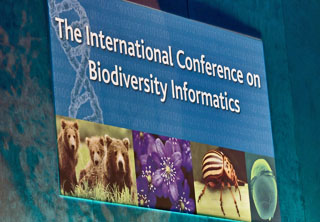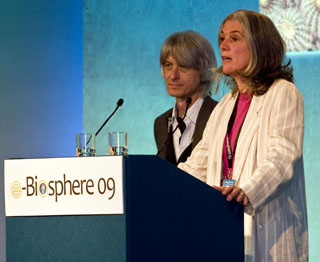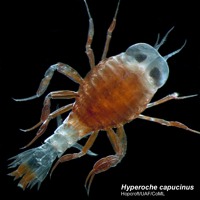Navigation
Experts creating online 'macroscopic observatory' of Earth's biodiversity
A virtual observatory for the unprecedented study and monitoring of life in an integrative way is under construction by some 400 biology and technology experts from 50 countries.
|
A virtual observatory for the unprecedented study and monitoring of life in an integrative way is under construction by some 400 biology and technology experts from 50 countries, who are meeting in London June 1 to 3, 2009. Biodiversity information and innovative internet architecture are being used to create a seamless, global view of life. With the benefit of a high-tech field guide for 21st Century, public observations will help map world biodiversity, monitor climate change, and conserve species.
 |
| Photo copyright NHM |
Biodiversity information and innovative internet architecture are being used to create a seamless, global view of life. With the benefit of a high-tech field guide for 21st Century, public observations will help map world biodiversity, monitor climate change, and conserve species. Hosted by the Natural History Museum, London, and co-sponsored by the Encyclopedia of Life (EOL), based at the Smithsonian Institution, and 12 other leading biodiversity research institutions, 400 experts from 50 nations participating at the first e-Biosphere 09 International Conference on Biodiversity Informatics held at the at the Queen Elizabeth II Conference Centre.
They are applying the latest in information technologies to build new software tools that make a global, free access biodiversity information network a reality.
Participants will accelerate their fusion into a powerful information apparatus of historic promise for biodiversity mapping, climate change monitoring and species conservation, among many other benefits.
Within 10 years, scientists say, they could have an efficient and effective way of tracking changes over time in the range and abundance of plants and animals as worldwide temperature and precipitation patterns shift.
The online information system for life on Earth, now under construction, will take its place alongside the global network that records earthquakes, or the world meteorology data network that pools information to predict the weather.
"We are creating a virtual observatory for world biodiversity, where environmental observations, specimen data, experimental results, and sophisticated modeling can be done across all levels of biodiversity -- from genes to ecosystems," says organizer James Edwards, Executive Director of the Encyclopedia of Life, Washington DC. "Information about the biology and distribution of Earth's species is enormously important to science and our quality of life. And the impact of that information increases tremendously when it is connected and made easily accessible online to all."
The integrated global knowledge base being created will also function as a high-tech "field guide" for the 21st Century, Dr. Edwards explains, allowing citizen users to click seamlessly from images of a plant or animal specimen, to information about its species and genetic code, to maps of its range and more.
Interested in the forest on your favorite mountain trail? You'll soon be able to start with an online satellite image, then click to obtain the wanted information - from the forests' tree species, the shapes of each tree's leaves and the color of its flowers, the insects that feed on the flower, to the DNA of microbes that live in the insects.
Wanted (soon): observations from environment-minded citizens that will allow science to study biodiversity at a planetary level in a massive,
comprehensive virtual observatory of historic importance.
Or start small and move up. Found a strange insect in your garden? Online identification guides, digital images and maps, and global databases will help puzzle out the species name, where it came from and whether it's a harmful invasive species.
Then join tens of thousands of users who report their observations and build the global database - an army of citizen scientists who help reveal and verify planetary changes such as the density and area of forest cover or the time plants flower locally.
What may sound like a Star Trek fantasy in fact is a high-tech tool within reach, with many components already in place.
Other public interest benefits, some already being realized, include the improved management of:
- Bilateral trade and biosecurity, through pest and alien species detection and quarantine;
- Human health and medicine, through the authentication of medicinally-useful plants, identification of harmful algae, the origin of animal-related viruses and other human health threats, and the unravelling of diseases;
- Agriculture and fisheries, through the identification of disease and drought-resistant plants, fish stock assessments and by-catch identification, as well as timely identification of fungus, pests and other hazards - information of high economic value. Indeed, studies show the early identification of an invasive pest in Africa, for example, saved produce worth billions of dollars;
- Consumer and environmental protection, by revealing, for example, which species of fish are mislabelled and sold in grocery stores and restaurants, which processed wood products in the marketplace have been illegally harvested and imported, and if canned dog food contains only the things noted on the label;
- Aviation, through the identification of birds struck by aircraft, and the timing, altitude and routes of their migrations.
Expert groups are working on key aspects of this massive undertaking, from images of species (ARKive), to maps of the marine environment (Aquamaps), to genes (DNA barcoding of species), to display portals, to name but a few. The conference in London represents a landmark step towards the integration of these elements to achieve a dynamic new scientific capability.
Biological informatics, and its subset biodiversity informatics, grew out of a union between biologists and "informaticians" - the branch of computer science that deals with managing data and making it available to users.
Thanks to biodiversity informatics, scientists can create a "virtual observatory" to describe, analyze and model world biodiversity at scales that transcend simple landscape. Biomes, ecosystems, phyla, flora, fauna, hotspots, rarities, genetic erosion, and the impact of alien species - none of these can actually be physically "observed"; understanding requires the synthesis of information from extensive primary data.
About half of the conference participants will present their work, highlighting connections between their studies of the Web of Life with others underway elsewhere:
- Projects advancing the field of 'cyber-taxonomy,' enabling the world's relatively small community of trained experts to reveal what may be millions of undiscovered species. Computerized systems can now analyze features like a leaf's shape and compare it to reference databases, identifying many new species in the process;
- More than 40 projects worldwide creating public databases of species and museum specimens in a country or region, like the plants of the Russian Federation, the weed species of Mexico, or the mosses of Malaysia;* More than 50 projects putting web-based data to work for research or societal applications, like GISIN, a global information network on invasive species, or a database for mapping species distributions in Kenya's Amboseli National Park, designed to protect endangered species and manage protected areas;
- Projects integrating data on the distributions of plants and animals with information on environmental factors like temperature, rainfall, and soil types. These integrated systems allow researchers to monitor changes in species distributions and to study the effects of climate change and other human impacts.
Under construction is an integrated online platform for:
- Analysing global biodiversity, including across time, geography and species; and
- Moving beyond analysis to global biodiversity modelling, past, present and future.
More than 30 other organizations will demonstrate how they are collecting, synthesizing, aggregating and publishing massive assortments of global information, including:
The Natural History Museum, London, which is building software tools that enable researchers worldwide to collaborate online, sharing their data and synthesizing their results;
The Consortium for the Barcode of Life, linking species names to diagnostic DNA sequences, allowing researchers and others to identify species using standard lab techniques
The Global Biodiversity Information Facility providing access to primary biodiversity data records, currently over 170 million, from natural history collections and field observations around the world;
The Encyclopedia of Life, aggregating data from diverse sources to create an online page for every known species - 1.8 million in all. The Biodiversity Heritage Library, one of EOL's subprojects, is digitizing millions of pages of published research that will enrich the content of the species pages.
Science challenge: from species discovery to online description in three days
In order to demonstrate powerful possibilities already in place, teams of scientists will compete during the conference in a unique race to show how rapidly new information in biology can be distributed through and connected to the existing web of biodiversity information. For example, teams may attempt to complete within three days the entire process involved in the formal identification of new species - from its discovery to peer-reviewed description - a process that has typically involved at least months, often years. The progress of the challengers can be followed by anyone online at www.e-biosphere09.org/page/31/the-e-biosphere-09-informatics-challenge.
Next steps for building the world biodiversity macro-lab
Explore poorly known taxonomic groups and assemble the data;
Create access to specimens and data in more countries;
Get "do-it-yourself" database operators into the network;
Document with contributors how data were collected;
Build automated tools to find and suggest corrections to inconsistencies in or between datasets to improve data accuracy and consistency;
Create online keys that help identify hundreds of thousands of species from minimal initial information such as color, shape and locale;
Complete digitization, with open access, of past biodiversity literature;
Promote the use of sites and functions showcased at e-Biosphere 09 for the production of national assessments required by the International Convention on Biodiversity.
Says David Schindel of the Consortium for the Barcode of Life (CBOL), also based at the Smithsonian Institution: "In addition to showcasing emerging technologies like DNA barcoding and their potential benefits to science and society, this conference will help identify gaps in our knowledge of the living world, fill those gaps, and be sure that the connections among information sources are working smoothly. This means making sure that the people who collect data and put it on the web are using the same protocols, so the data are really consistent and comparable. For example, there are a lot of ways of measuring your position on Earth and reporting that on the web."
 |
| Professor Norm MacLeod, Keeper of Palaeontology at the Natural History Museum (NHM) and Dr Sandy Knapp, Merit Researcher in the Botany Department, the NHM). Photo copyright NHM |
Prof. Norman MacLeod, The Natural History Museum's Keeper of Palaeontology, comments: "The democratization of biodiversity information is a development of profound importance being accomplished through integrated, easy-to-use tools that allow anyone in the world to extract, manipulate, interact with and contribute information about the plants, animals, microbes, fungi, and other organisms with which we share this planet.
"Tools under development to achieve this goal range from fiendishly complex mathematics of automated species recognition software to teaching aids that will allow schoolchildren to access and analyse primary scientific data for class reports."
"Forty years ago astronauts took pictures of Earth from the Moon. e-Biosphere 09 is creating a 'macroscope' that will allow billions of people to zoom from the moon to Madagascar to a monkey and its DNA," says Jesse Ausubel, a Program Director of the Alfred P. Sloan Foundation, New York.
Hosted by: Natural History Museum (NHM), London, e-Biopshere 09 is co-sponsored by:
· Alfred P. Sloan Foundation
· www.mellon.org
· Atlas of Living Australia
· BioNET-INTERNATIONAL
· Consortium for the Barcode of Life
· Darwin200
· Encyclopedia of Life
· European Distributed Institute of Taxonomy
· Global Biodiversity Information Facility
· Inter-American Biodiversity Information Network
· JRS Biodiversity Foundation
· LifeWatch
· Pan-European Species-directories Infrastructure
· US National Biological Information Infrastructure
Related articles on the Horizon Solutions Site include:
and
Search
Latest articles
Agriculture
- World Water Week: Healthy ecosystems essential to human health: from coronavirus to malnutrition Online session Wednesday 24 August 17:00-18:20
- World Water Week: Healthy ecosystems essential to human health: from coronavirus to malnutrition Online session Wednesday 24 August 17:00-18:20
Air Pollution
- "Water and Sanitation-Related Diseases and the Changing Environment: Challenges, Interventions, and Preventive Measures" Volume 2 Is Now Available
- Global Innovation Exchange Co-Created by Horizon International, USAID, Bill and Melinda Gates Foundation and Others
Biodiversity
- It is time for international mobilization against climate change
- World Water Week: Healthy ecosystems essential to human health: from coronavirus to malnutrition Online session Wednesday 24 August 17:00-18:20
Desertification
- World Water Week: Healthy ecosystems essential to human health: from coronavirus to malnutrition Online session Wednesday 24 August 17:00-18:20
- UN Food Systems Summit Receives Over 1,200 Ideas to Help Meet Sustainable Development Goals
Endangered Species
- Mangrove Action Project Collaborates to Restore and Preserve Mangrove Ecosystems
- Coral Research in Palau offers a “Glimmer of Hope”
Energy
- Global Innovation Exchange Co-Created by Horizon International, USAID, Bill and Melinda Gates Foundation and Others
- Wildlife Preservation in Southeast Nova Scotia
Exhibits
- Global Innovation Exchange Co-Created by Horizon International, USAID, Bill and Melinda Gates Foundation and Others
- Coral Reefs
Forests
- NASA Satellites Reveal Major Shifts in Global Freshwater Updated June 2020
- Global Innovation Exchange Co-Created by Horizon International, USAID, Bill and Melinda Gates Foundation and Others
Global Climate Change
- It is time for international mobilization against climate change
- It is time for international mobilization against climate change
Global Health
- World Water Week: Healthy ecosystems essential to human health: from coronavirus to malnutrition Online session Wednesday 24 August 17:00-18:20
- More than 400 schoolgirls, family and teachers rescued from Afghanistan by small coalition
Industry
- "Water and Sanitation-Related Diseases and the Changing Environment: Challenges, Interventions, and Preventive Measures" Volume 2 Is Now Available
- Global Innovation Exchange Co-Created by Horizon International, USAID, Bill and Melinda Gates Foundation and Others
Natural Disaster Relief
- STOP ATTACKS ON HEALTH CARE IN UKRAINE
- Global Innovation Exchange Co-Created by Horizon International, USAID, Bill and Melinda Gates Foundation and Others
News and Special Reports
- World Water Week: Healthy ecosystems essential to human health: from coronavirus to malnutrition Online session Wednesday 24 August 17:00-18:20
- STOP ATTACKS ON HEALTH CARE IN UKRAINE
Oceans, Coral Reefs
- World Water Week: Healthy ecosystems essential to human health: from coronavirus to malnutrition Online session Wednesday 24 August 17:00-18:20
- Mangrove Action Project Collaborates to Restore and Preserve Mangrove Ecosystems
Pollution
- Zakaria Ouedraogo of Burkina Faso Produces Film “Nzoue Fiyen: Water Not Drinkable”
- "Water and Sanitation-Related Diseases and the Changing Environment: Challenges, Interventions, and Preventive Measures" Volume 2 Is Now Available
Population
- "Water and Sanitation-Related Diseases and the Changing Environment: Challenges, Interventions, and Preventive Measures" Volume 2 Is Now Available
- "Water and Sanitation-Related Diseases and the Changing Environment: Challenges, Interventions, and Preventive Measures" Volume 2 Is Now Available
Public Health
- Honouring the visionary behind India’s sanitation revolution
- Honouring the visionary behind India’s sanitation revolution
Rivers
- World Water Week: Healthy ecosystems essential to human health: from coronavirus to malnutrition Online session Wednesday 24 August 17:00-18:20
- Mangrove Action Project Collaborates to Restore and Preserve Mangrove Ecosystems
Sanitation
- Honouring the visionary behind India’s sanitation revolution
- Honouring the visionary behind India’s sanitation revolution
Toxic Chemicals
- "Water and Sanitation-Related Diseases and the Changing Environment: Challenges, Interventions, and Preventive Measures" Volume 2 Is Now Available
- Actions to Prevent Polluted Drinking Water in the United States
Transportation
- "Water and Sanitation-Related Diseases and the Changing Environment: Challenges, Interventions, and Preventive Measures" Volume 2 Is Now Available
- Urbanization Provides Opportunities for Transition to a Green Economy, Says New Report
Waste Management
- Honouring the visionary behind India’s sanitation revolution
- Honouring the visionary behind India’s sanitation revolution
Water
- Honouring the visionary behind India’s sanitation revolution
- Honouring the visionary behind India’s sanitation revolution
Water and Sanitation
- Honouring the visionary behind India’s sanitation revolution
- Honouring the visionary behind India’s sanitation revolution


